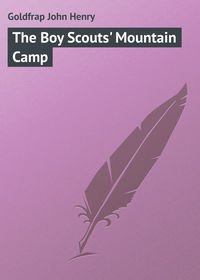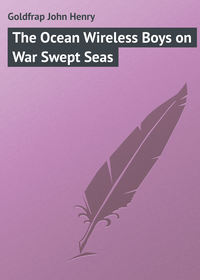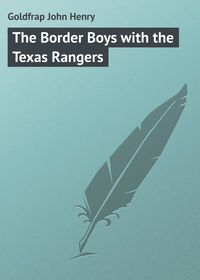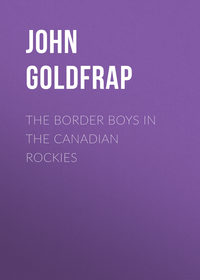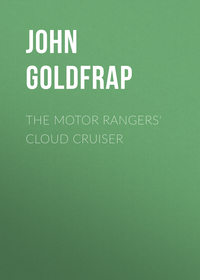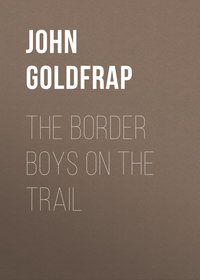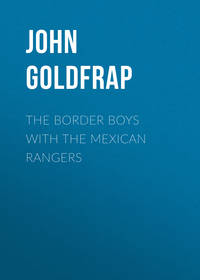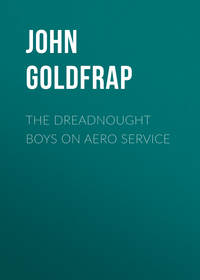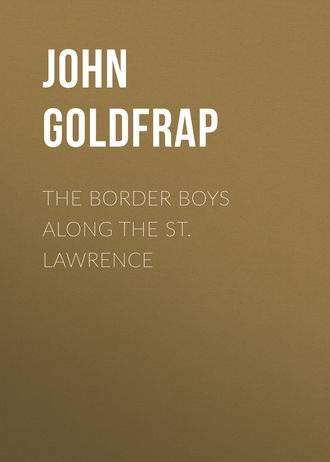 полная версия
полная версияThe Border Boys Along the St. Lawrence
In yet another volume, the experiences of the lads with the rurales of Mexico were set forth. This book was called “The Border Boys with the Mexican Rangers,” and painted a picture of life in the wilder parts of old Mexico amid rugged mountains and brigand-infested plains. A clever use of an extemporized heliograph was made by the lads and saved them from a predicament into which they had been forced by a stupendous cloud-burst which swept their camp away. At a lone ranch, too, they met with some surprising adventures which culminated in a ride for life across the plains. At a grand fiesta they won several of the prizes, a feat which earned them the still further enmity of men who had good reason to dislike and fear them. In old Mexico, the land of fascinating romance, the boys surely had their full share of incident and adventure, and their experiences served to strengthen their characters and broaden their minds. To cope successfully with difficulties forms the best sort of training for lads, and our Border Boys showed that when it came to the test they were not lacking in energy or grit.
A fifth volume, called forth by the demand on the part of our readers to follow the boys still further through their lives, dealt with a different phase of their existences altogether. In “The Border Boys in the Canadian Rockies” the lads traveled on their sturdy little mustangs through a wild and rugged country. Not the least interesting phase of their experiences dealt with the mystery surrounding Jimmy, the waif, who came into their lives when they landed at a tiny way station on the Canadian Pacific Railroad. Several mysterious happenings, too, puzzled and annoyed them not a little while they were on their journey to the Big Bend of the Columbia River. These incidents involved a man of strange personality who, for no apparent reason, harassed and alarmed them on numerous occasions. However, in the end all that had appeared inexplicable was cleared up, and Jimmy, the waif, came into his own at last.
About two months before the present volume dealing with their adventures opens, the lads had accepted the invitation of Ralph Stetson’s father to spend some time with him at his estate on Dexter Island, in the wonderful St. Lawrence River, that mighty outlet of the Great Lakes, which rolls its turbulent current along the border line between the United States and Canada. The scene of much historical interest in the past, the making of history is still going on along the St. Lawrence. Both the United States and Canada keep a sharp lookout for smugglers and other evildoers along the line which extends through the exact center of the great river. Interesting adventures are of almost daily occurrence in that region.
Beginning with the night upon which we encountered them in the rapids, the boys were destined to be plunged into experiences along the international boundary line that would demand all the resourcefulness and efficiency which had been developed in them by the scenes through which they had already passed.
But for the time being, at any rate, the mystery of the ghostly craft had to wait for a solution. The next day was the one selected by the boys for a joyous excursion on their swift, sure craft down the historic waters of the St. Lawrence, which has been called “the noblest, the purest, the most enchanting river on God’s beautiful earth.”
For a thousand miles from Lake Ontario to the sea the mighty current of the great waterway runs, embellished with islands and made beautiful by leaping rapids and swirling whirlpools. Except to the specially built river steamers these rapids, that is the larger ones, are not navigable except on the way down the river. Coming up, even the most powerful craft have to take to the canals, of which there are several, all on the Canadian side and free to all commerce.
The boys planned a quick trip down to Montreal and thence to Quebec. The return trip would have to be made more slowly, owing to the obstacles already mentioned.
Having provisioned the River Swallow, on which they intended to make their home during the cruise, there was nothing left to do but to start up the engines and set out. For this trip Malvin and Hansen were left behind, as Mr. Stetson needed them to do some work about the island and they were not actually required on the river craft.
It was a glorious morning when the boys started out. The sun lay glitteringly on the clear, swiftly flowing waters, and the River Swallow glided from her dock as if she were as pleased with the prospect of the cruise as were the boys.
Ralph Stetson, naturally studious, had found much to interest him in the history of the great river they were navigating; and, indeed, no stream in the world has more storied interest than the mighty water course that marks the border of the United States and Canada.
Jacques Cartier is generally given the credit of the discovery of the St. Lawrence, although some historians mention other candidates for the honor. Ralph’s studies told him that little is known of Cartier, beyond the fact that he belonged to a hardy race of French fishermen.
By some writers he is even referred to as a corsair, although there does not appear to be much evidence to support this theory. It was not until his second voyage, however, that Cartier really entered the river, to the mouth of which he gave the name of the Bay of St. Laurens.
With the spirit of exploration strong upon him, Cartier pushed onward, hugging the southern shore of a river eighty miles wide. To his mind, he had found the Mecca of every explorer of that day: the visionary passage to Cathay. For to discover a waterway to the far east was the dream of every early voyager.
As he sailed onward, mighty rock walls rose up majestically on each side of the great stream he was traversing. Gray rocks piled themselves tier upon tier, topped by huge forests and backed by glimpses of mountains beyond.
Then came bold headlands, thrusting their fronts into the river. From day to day the scene shifted, with the current ever increasing in swiftness. The rocky headlands gave way to long level reaches of swampy land. Cartier, in his records, speaks of the innumerable crows that haunted these marshes, although there were plenty of duck and other wild fowl.
But at last Cartier began to realize that he had not stumbled on the passage to Cathay as he had fondly dreamed.
The year before he had taken two Indians captive. They were still part of his crew. He summoned them before him.
“What river is this?” he asked.
One of the Indians pointed majestically to the west.
“The river without an end,” he said solemnly.
Cartier found the Indians extraordinarily skillful in managing their frail birch bark canoes, even in the wildest of the rapids. He was greatly interested in all the different tribes which he encountered. Many of them were at war with each other, although all sprang, according to present-day opinion, from the Cree stock.
The old French traveler says that he found the Indians friendly. He describes a visit to one of their towns, which stood at the base of a hill surrounded by cornfields, with the river and the primeval forest beyond. This village, occupied by a tribe known as the Amerinds, was well fortified, as were all the villages of this tribe, by a high stockade.
With a body guard of twenty of his men Cartier entered the walled village. They found inside the stockade a gallery from which missiles could be hurled down on any foe. Piles of stones lay in readiness for this purpose.
Behind the village stood an imposing height of land which Cartier, impressed by the noble view from its summit, named Mont Royale. This was the origin of Montreal, which city stands on the site of the stockaded Indian village of Hochelaga.
It was too late in the season when the bold investigator reached this village to press on further, and he therefore made his way back to winter quarters at Havre de St. Croix on the St. Charles River. His experiences during the “white winter,” as he called it, were enough to daunt even his courageous spirit. To add to his troubles, his men contracted scurvy, and many died before spring came, from the close confinement and lack of proper food.
The Indians brewed for the sufferers a sort of tea of pine boughs and bark called “ameda,” which appeared to have a good effect on the victims and, in Cartier’s opinion, saved the lives of many of them.
He returned to France and, some time later, made a third voyage. This time it was a trip for colonization. But the little colony suffered terrible privations and much illness and misery, and it was to the Indians that they owed what succor in the way of provisions and primitive medicine they were able to obtain. Cartier sailed back to France, leaving the remnants of the colony, and never returned again.
Then came Champlain, the founder of Quebec. It is a far cry from the noble city of Quebec as it is to-day to the huddle of huts erected in the form of a square by Champlain, and surmounted by a dovecote on the top of a pole to symbolize his peaceful intentions. Of his discovery of the historic lake that bears his name it would be beside the mark to speak here, inasmuch as this necessary digression is simply to acquaint our readers with a little of the history of the river on which our Border Boys were destined to meet such surprising adventures, and with the city of Montreal, to which they were now bound.
CHAPTER V
DOWN TO MONTREAL
The run down the river to Montreal was made rapidly and without incident. The boys found the slow progress they had to make through the canals adjoining the Lachine and Long Sault rapids, which they could not descend, rather tedious. Nevertheless, they thoroughly enjoyed watching one of the red-funneled excursion steamers from up the river shoot through the boiling waves and cascades, apparently to certain destruction.
At the Lachine Canal they were “locked down” eighty-two feet, passing through three locks in the process. They arrived at Montreal, Canada’s “White City,” that evening. The next morning they devoted to seeing the sights of the town.
Perhaps some extracts from a letter written some days later by Ralph to a school chum will give our readers a boy’s idea of this city and of Quebec.
“About the first thing we noticed,” wrote Ralph, “was the Victoria Bridge, which spans the south channel of the St. Lawrence and carries the rails of the Grand Trunk Railway. It is almost two miles long, has twenty-four spans, and hangs sixty feet above the river. We saw it first in the twilight. It looked like a black ribbon stretched across the sky.
“Montreal is the queerest city from the point of view of design that I ever saw. It is built up from the river in a series of terraces. It is chock full of fine buildings, as fine and finer than any in New York, but of course not so tall. There is the big cathedral of Notre Dame, with twin towers like the one in France. It has a bell weighing 24,780 pounds, the heaviest bell in North America. The church will seat fifteen thousand people.
“The ice cream sodas here are not good. We know, for we sampled them. But I was going to tell you, under Notre Dame Street are buried the bones of Le Rat, a Huron chief, who broke the peace pact between the French and his tribe. He fell dead as a door nail while addressing a lot of Hurons and French who had come together to have a pow-wow.
“We didn’t spend very much time here, however, being anxious to get on to Quebec. Besides, something happened the other night at the island that we are anxious to get back to solve. I can’t tell you more about it now than to say that it was a ‘ghost ship’! That sounds promising, doesn’t it?
“Now, to tell you something about Quebec. I am mighty glad to have been there. It is truly a wonderful city. Somebody told us that it got its name from Cartier exclaiming, as he saw the three-hundred-foot rock that rises from the river, ‘Que bec!’ Knowing that you are not much of a French scholar, I will translate. That means ‘What a beak!’ And so that is how Quebec got its name, and, if you’d ever seen it, you would think it was a good one.
“I can’t describe the city better than to call it a huge cliff all stuck over with spires, roofs, chimneys, ramparts and muzzles of antiquated guns that a modern piece of artillery could knock into a cocked hat. Cape Diamond, as the immense rock is called, is all tufted with patches of shrubs. It made me think of Professor Crabtree’s face. You know: all hard and rugged, with whiskers scrawling over it!
“The Lower Town, as it is called, lies at the base of this rock. Here is the water-front section, and streets that turn and twist about like corkscrews. It is a smoky, ancient, old place full of queer smells and business.
“You get out of it to the Upper Town by Mountain Street, and it’s all of that! They say that till thirty years ago a carriage couldn’t get up it, but it has been graded so that now you can drive up. We walked, thinking it would be good exercise for Persimmons, who hates walking, anyhow.
“The citadel is a wonderful place perched up on a high rock, and you can see all over the region from it. One thing to be seen there is a brass cannon the Britishers captured at Bunker Hill. No wonder they’re proud of it. I guess it’s about all they did get.
“The Citadel runs, in the form of a big granite wall with towers and bastions stuck on it at regular intervals, all along the brow of the height overlooking the city, like a wrinkle on a forehead. Quebec, as perhaps you know, is the only walled city in America. It certainly is a great place to see. You might think that you were looking down from the Citadel on some old town in the middles ages – except for the tourists with their cameras!
“We went out to the Plains of Abraham; that is, Persimmons didn’t go, having overeaten on some cake he made himself and we wouldn’t touch, having sampled his cooking before. This is the place where Wolfe licked Montcalm. But both their names are carved on a monument just as if they had fought side by side.
“In the Post Office, where I am going to mail this letter, there is a block of granite from an old building that once stood on its site. It was called the Chien d’Or, or the Golden Dog. There is a story connected with Phillibert, the merchant who built it. He came here when Bigot, a ‘grafter’ or ‘boss,’ as we should call him nowadays, had control of the city and of New France. He ran things to suit himself and pocketed all kinds of crooked money. Phillibert ran a sort of department store and fought Bigot all he could. Over the door of his store he had the figure of a dog cut. It was gnawing a bone. The dog was meant to be Bigot and the bone the country he was ‘grafting’ on. Bigot got so sore at this that he had his brother-in-law assassinate Phillibert.
“There are more churches here than in any place I ever saw. The folks of Quebec ought to be the best in the world. Near the market in the Lower Town is one of the first churches built in America. A porch was built over its door as a token of thanksgiving when a fleet of British ships on its way to wallop Quebec was wrecked off the mouth of the St. Lawrence.
“Near where this church stands is a place where they will tell you Champlain lived in 1608 and planted the first garden in the country with seeds brought from France. In a convent on Garden Street Montcalm is buried. The Canadians have marked all these places with tablets. I think it would be a good scheme to do the same thing with historic places at home.
“But you are probably getting tired of all this. Tell the fellows we are having a great time and expect to have a better. Anyhow, I will write you before long how we come out about that queer motor boat. We are going to find out what is up; you can bet your life on that.
“Always your pal,“Ralph.”CHAPTER VI
HOMEWARD BOUND
The next day the boys, enriched by many postcards and souvenirs, set out on their return trip. They voyaged along under the high banks of the St. Lawrence, from Cape Diamond to Cape Rouge, drinking in every bit of the striking scenery with interest.
About a mile above Wolfe’s Cove they passed the historic little village of Sillery, where, in the stormy days of the Christian conquest of Canada, the Jesuits called about them the Hurons and preached to them in a language of which the wondering Indians, listening with stoical patience, understood not a word.
In later years there came a dispute as to whether the land about Sillery belonged to the Jesuits or the Hurons. The British decided in favor of the Jesuits, but offered the Hurons other lands. These they refused, and the red men soon melted away into the forests to dwindle ultimately to extinction.
About midway between Quebec and Montreal the boys stopped at the town of Three Rivers, so called from the fact of its being on the triple junction of the St. Maurice River with the St. Lawrence. Three Rivers was an important early trading post, being the head of tide water on the St. Lawrence. Champlain erected a fort there on the site of a primitive defense built by the Algonquins and destroyed by the Iroquois. It was from here, too, so Ralph was able to inform his chums, that Father Brebeuf set forth with a party of Hurons to preach in the farthest wilderness.
The good father, according to history, was as much of a fighting man as a preacher. He taught the Indians how to build fortifications and to palisade squares with flanking towers, which were a vast improvement on their round stockades.
The boys stopped at a dock adjoining a small farmhouse, not far from Three Rivers, to buy some fresh provisions, for Persimmons’ experiments in cookery had proved disastrous to their larder.
The place was kept by a descendant of the old “habitants” of the country, a man as brown as a berry, with high, Indian-like cheek bones and beady black eyes. His house must have stood there for hundreds of years. It was of rough, whitewashed stone, and had a steep roof, with a huge chimney at one end.
While they were waiting for the fresh milk and the eggs that the habitant promised to produce promptly, they gazed about the living room into which they had been ushered.
Its rough walls were whitewashed and adorned with crude pictures, chiefly of religious subjects. Ropes of onions, hams and dried fruit hung from the roof beams. In a corner, snowshoes and sleds and firearms told a mute story of the severity of the Canadian winter. It was all as it might have been in the days of the earliest settler.
But, if the people were primitive, they had a clear idea of how to charge for their viands! There was no help for it but to pay the bill, while the cunning little eyes of the habitant surveyed the roll from which Ralph peeled the required amount. He was plainly wishing that he had charged twice as much, particularly when he saw the fine boat the boys had.
The return trip through the canals with occasional stretches of clear water was monotonous. Nothing occurred out of the ordinary. But the delay in the canals and a slight overheating of the machinery resulted in its being dark by the time they neared their island.
“Well, we’ve had a grand trip, but I’m glad to be back again,” declared Ralph, as they came into familiar waters once more.
“So am I,” agreed Hardware. “I’ll be glad to get a decent meal again.”
He glanced in an aggravating way at Persimmons, who had been the ship’s cook and bottle washer, as well as engineer at times, and was now getting a breath of fresh air above deck. He ducked just in time to avoid a well-aimed piece of oily waste which Persimmons, justly indignant, flung at him.
“Next cruise we take,” declared the disgruntled lad, “you can take the pots and pans, Hardware. And I’ll bet that anything you make will taste like your name!”
“I’d rather it did than like an unripe persimmon!” declared Hardware. Then Ralph had to exercise his good offices to make peace between the belligerents. But soon more important matters occupied their minds.
The strange craft that they had almost forgotten on their cruise of sight-seeing came back now with vividness to their recollections. The surprising appearance and equally startling disappearance of the mysterious motor boat were recalled as they threaded home waters again. As the River Swallow moved through the darkness with her electric side and bow lights glowing like jewels, each boy was busy with speculations concerning it.
Their reveries were cut short by a sudden shout which appeared to come from right under the bow.
“What was that?” exclaimed Hardware in a startled tone. He was alone on the bridge with Ralph. Persimmons was below, having returned to his engines.
“Jiggered if I know! Somebody shouted, though. It was right under the bow.”
“That’s what I thought. Hark, there it is again!”
Both boys strained their ears. Unmistakably a hail had come out of the darkness.
“Clap on the search-light quick, Hardware,” ordered Ralph.
The boy snapped the light on. It blazed out fan-like in the night, cutting a broad circle of light that revealed the whole river as Hardware swept it from side to side. Suddenly he gave a shout and pointed.
Embraced in the circle of light, and right under their bow almost, was a frail boat. In it were seated two Indians. Their craft was piled high with baskets which they had been trying to sell among the islands.
The boys knew at once that the red men came from a reservation down the river and belonged to the St. Regis tribe.
“They’re coming right down on us!” cried Ralph.
“What’s the matter with them?” cried Harry. “I see,” he added immediately, “they’ve broken their paddle. See, they are waving the stump of it in the air! Steer out, Ralph! Steer out, or you’ll run them down!”
“I – I can’t,” exclaimed Ralph in an agitated voice.
“Can’t! Why not?”
“Don’t you see where we are? There are rocks on each side. If I turn out we’ll be ripped like an egg shell on them.”
“Gracious, that’s so!” And then Hardware noticed for the first time that they were running through a narrow channel between two islands.
CHAPTER VII
RUN DOWN
Something must be done. In another moment the frail boat would be drawn by the current right down on the bow of the River Swallow and cut in two. But there was no room to turn out or avoid them!
Ralph was the first to gain possession of his senses. He sounded the gong impatiently for Persimmons. Then in the same breath he ordered Hardware to hand him one of the life belts.
“Now then, you take a rope and when we strike them, for it can’t be helped,” he breathed, “lower it over and try to catch one of the men. I’ll get the other.”
Young Ware with compressed lips nodded. At the same moment Persimmons came on deck.
“Take the wheel, Perce,” exclaimed Ralph in a low tense voice, “and keep going upstream whatever happens.”
“What’s going to happen?” asked the alarmed boy.
“In another second we are going to hit an Indian canoe. If we can we are going to save their lives. Hold fast!”
There was a grating bump and a jar, and a cry of alarm came out of the night. Hardware cast his rope, while Persimmons, with a white face and strained muscles, kept the River Swallow on her course. Ralph had taken off his boots; now he ran to the other side of the bridge.
For a flash he saw below him an upturned face, borne past with the rapidity of lightning on the swift current. He cast the life preserver, which had a rope attached to it. To his joy he felt the life-saving device caught and the rope grow taut. But the next moment, under the sudden strain of his weight, a line, stretched across an opening in the bridge against which he had been leaning, parted.
While the other lads set up a yell of alarm, they saw Ralph jerked from the bridge into the tempestuous current. Ralph struck the water and went under.
When he came to the surface, he felt as if a hundred hands had hold of him drawing him under again. Weighted by his clothes, he was sadly handicapped. But he made a valiant fight for it. He still held the rope, but he was unable to reach the life preserver, because it was borne down stream with the Indian clinging to it, as fast as he was.
For what appeared an eternity the battle kept up, and then Ralph felt himself suddenly hurled upon some rocks. Gripping them with the grasp of desperation he hauled himself out of the water and laid hold of the rope with both hands.


